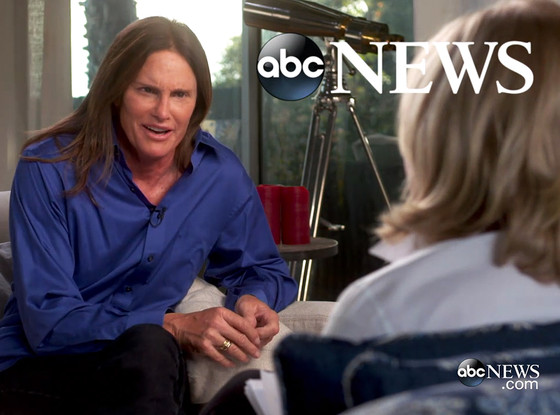A Scientist Comments on the Jenner Interview
 One of the producers of the Diane Sawyer interview with Bruce Jenner found my recent book. She was pleasantly surprised that TSTG science actually existed. She asked me to critique the show. This is a shortened version of my 6-page response. (I have used masculine pronouns as Jenner requested.)
One of the producers of the Diane Sawyer interview with Bruce Jenner found my recent book. She was pleasantly surprised that TSTG science actually existed. She asked me to critique the show. This is a shortened version of my 6-page response. (I have used masculine pronouns as Jenner requested.)
Here are some of my comments on the interview. I saved the criticisms for last.
1. The best thing about the interview was that Bruce came across as genuine and authentic although he seemed isolated from the transgender community. He realized that he does not have enough information to be an advocate but seems willing to learn. While many of his statements were not absolutely scientifically correct, he got the right general meaning across.
Comment: He needs more exposure to the transgender community in order to have support during his transition.
2. Bruce did a good job of articulating why he was coming out and transitioning. Such radical changes in behavior are usually the result of what psychiatrists call “existential crises.” A typical event that triggers such crises is a marriage breakup either through death or divorce.
Comment: The end of Jenner’s marriage occurred about the time he re-started transition. The split could have triggered an existential crisis. It would be interesting to see if Bruce and Chris reconcile.
3. It is surprising how early children learn about gender behavior categories and their transgenderism. Studies show that children know the fundamentals of gender by age 18 months-3 years and start to report transgenderism by 4-5. Doctor Olson’s (Children’s Hospital Los Angeles) comment about an 18-month child knowing they were transgender is the earliest I have heard, but I am not surprised.
Comment: Schools have been criticized for providing information on gender and transgenderism on the basis that children are not old enough to ready to learn and understand about gender. People need to realize that children are knowledgeable about gender at an early age (2-3).
4. Bruce glossed over the WPATH requirement for Real Life Experience in transsexual transition. This requires that one must live for one year in one’s preferred gender behavior category before genital plastic surgery (GPS) can be authorized. The psychiatrist is correct that Bruce should not rush into GPS. The RLE is a chance to work out problems, not a barrier.
Comment: Transition is not a race or a mountain-climb; the pace and criteria for success are individual and cannot be determined at the beginning.
5. The show gave the figure that there were 700,000 transgender people in the US. This number undoubtedly came from Gates at the Williams Institute. This figure is low. Conservative estimates show that there are at least 1,500,000 MTF transgender people. This estimate does not include FTM. Gates does not ever show his calculations, which is somewhat unprofessional. It is hard to understand where he got his numbers.
Comment: The estimate of the number of transgender people in the U.S. given on the show is undoubtedly low.
6. There were plenty of mix-ups over the words sex and gender in the show. If you do not keep these terms straight you run into all sorts of confusions between sex, sexual arousal, orientation and gender. Sex refers to organs; gender refers to behavior. The problem comes in when gender is used as a polite word for sex.
Bruce and Diane danced around the issue of what sexual orientation Bruce has and will have. Bruce is clearly a lesbian at this point but changes in sexual orientation occur for transsexuals. Some males become attracted to males and some females become attracted to females. For MTF they tend to occur after GPS but for FTM they occur after the start of hormone therapy. Bruce saved the discussion and Diane by saying he was asexual which actually does occur 10-20% in transsexuals but Bruce clearly is still attracted to females.
Comment: Athletic performance in rough sports and liking to drive big machines do not depend on gender or sex (See the US women’s soccer team, Danika Patrick and Shirley Muldowney).
7. Transgender people sometimes follow a path of “marriage flight.” The idea is that a marriage might provide a “cure,” a cover story, and perhaps a friend who might understand. Of course, there is no cure and marriage flight often ends in divorce. He indicated that being married improved his chances of maintaining his cover story. Bruce alluded to “where’s my beard.” For those of you who do not know, a beard is a term commonly used to describe the practice of homosexuals using someone of the opposite sex as an apparent date or spouse in order to conceal their sexual orientation. This results in apparent double dates that include both lesbians and male homosexuals. Bruce’s comment confused the conversation because of beard being associated with sexual orientation.
Comment: Marriage flight is common among transgender people.
8. Crossdressing versus gender identity. Bruce shows both the crossdressing behavior and claims his gender identity is female (feminine). I prefer using the crossdressing criteria because it can be observed. Terms like gender identity are slippery and rely on intervening variables that cannot be observed. If you crossdress and risk culture rejection that constitutes an acid test.
Comment: Behavior is the “best” evidence for transgenderism.
9. Bruce came right out and declared which pronouns to use for him and the status of possible GPS. People have a need to be called by the pronouns they prefer. No one should be asked about the status of their sex organs. If a person volunteers this information it is up to them.
Comment: Interview explained about pronouns but left open the question about asking transgender people about their genitalia.
10. Second worse error on the show. Cutaway to model of prenatal body while hormones are flowing. This is called the Prenatal Testosterone Theory of Transsexualism (PTTT) which states that prenatal exposure to low levels of testosterone produce MTF transsexualism and that high prenatal doses of testosterone produce FTM transsexualism. None of the scientific evidence supports the PTTT. The evidence does support a genetic cause for TSTG.
Comment: The PTTT is abroad in both professional and public domains but all the scientific evidence refutes it.
11. Worst error on the show was a cutaway to “Crossdressing and being transgender not the same thing. Many cross dressers do not want to change their bodies.” This was probably the worse error on the show. It was vague, illogical, incorrect and a non sequitur. There are plenty of accurate sources to draw on to make the points that I think they were making. Two minutes on Wiki could have avoided it.
Here is the correct way to say it (although admittedly a little long for a cutaway). Transgender people crossdress and present in a gender behavior category that is incongruent with their gender behavior category assigned at birth. Transsexuals are a subgroup of transgender people who want to change their bodies to better conform to cultural norms of a particular sex. Most transgender people are not transsexual. People crossdress for reasons other than being transgender, for example, entertainment (e.g. drag, theater) and political protest but they are not necessarily transgender.
Comment: This error was totally avoidable.
Category: Transgender Body & Soul, Transgender Community News, Transgender Opinion





Thats okay for a protection law but not for science.
Here again we are finding a shift in the use of “transgender” from what has been used to secure civil rights. It has long been a problematic term and I doubt that Dana’s refined use of it will even be the last word (and I think she would agree).
in 1998 San Francisco’s Human Rights Commission published “Compliance Guidelines to Prohibit Gender Identity Discrimination: San Francisco Administrative Code Chapter 12A, 12B, and 12C; San Francisco Municipal/Police Code Article 33” It set a precedent for the legal use of the term “transgender” for California and as a matter of course became a standard in other places as well.
A lot of debate has taken place on this definition including debate in civil rights organizations. But one group at the epicenter for change in California law, after months of debate, declined to change the definition because its objective was to benefit the greatest amount of people possible. The definition in the Compliance Guidelines as stated in the original document follows:
“‘Transgender’ is used as an umbrella term that includes female and male cross dressers, transvestites, drag queens or kings, female and male impersonators, intersexed individuals, pro-operative, post-operative, and non-operative transsexuals, masculine females, feminine males, all persons whose perceived gender or anatomic sex may be incongruent with their gender expression and all persons exhibiting gender characteristics and identities which are perceived to be androgynous.”